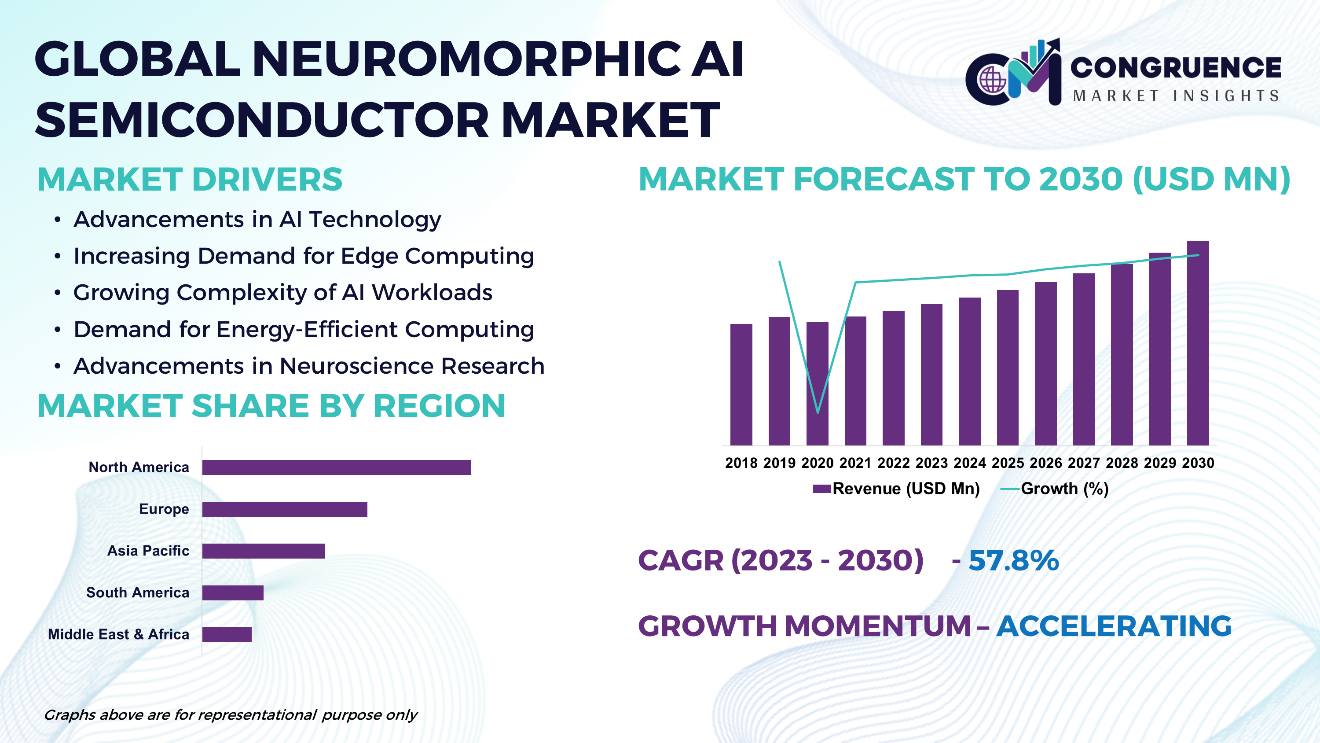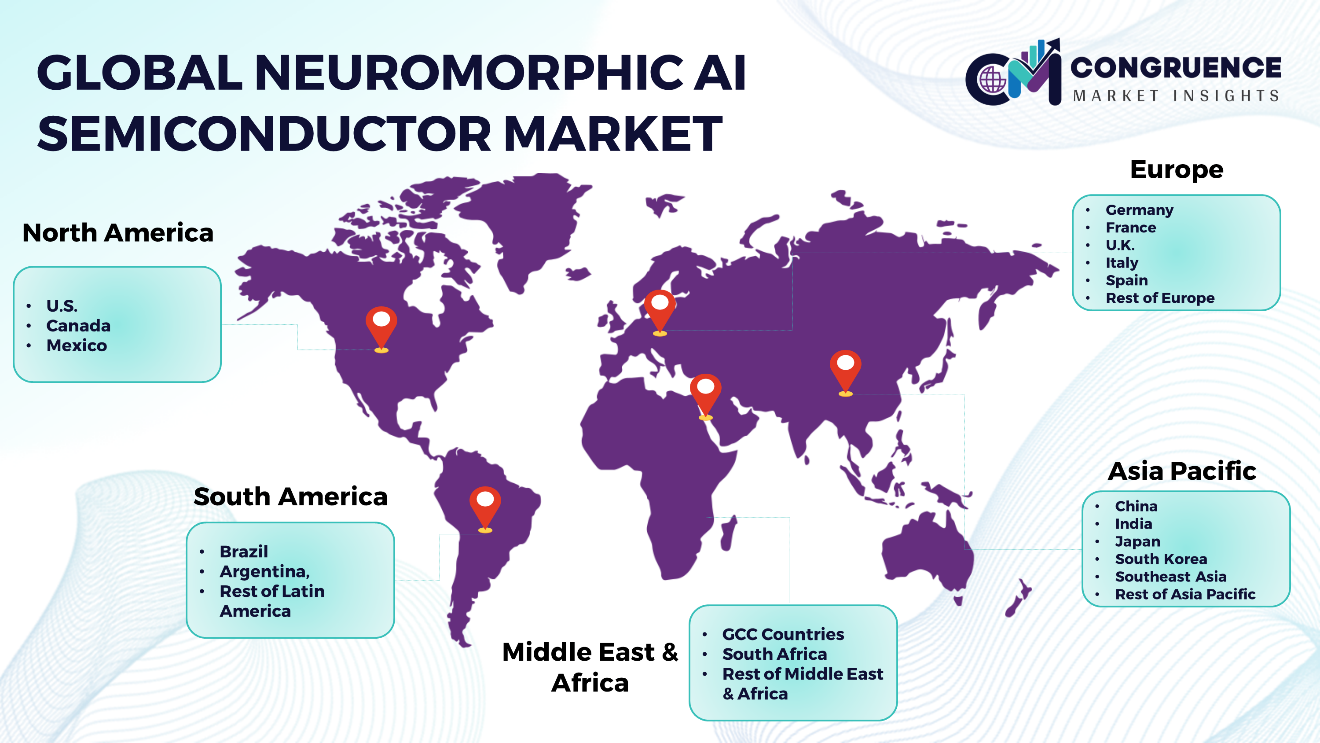Reports
The Global Neuromorphic AI Semiconductor Market is expected to expand at a CAGR of 57.8% between 2023 and 2030. The Neuromorphic AI Semiconductor market is experiencing rapid growth, driven by the escalating demand for high-tech solutions capable of mimicking the brain's neural networks. As the technology matures, its applications are diversifying, spanning from edge computing to autonomous vehicles. Neuromorphic AI Semiconductors are particularly instrumental in enhancing networking solutions, optimizing data processing and transmission for improved efficiency and speed. Moreover, the market landscape is evolving, with key players investing in research and development to meet the burgeoning demand and capitalize on emerging opportunities across various industries.

Neuromorphic AI Semiconductor Market Major Driving Forces
Advancements in AI Technology: Continuous advancements in artificial intelligence (AI) technology, particularly in neuromorphic computing, are driving the development and adoption of Neuromorphic AI Semiconductors. These advancements enable more efficient and intelligent processing of data, driving demand for specialized semiconductor solutions.
Increasing Demand for Edge Computing: The rising demand for edge computing solutions, driven by the proliferation of IoT devices and the need for real-time data processing, is fueling the growth of the Neuromorphic AI Semiconductor market. Neuromorphic chips offer low-power, high-performance computing capabilities ideally suited for edge applications.
Growing Complexity of AI Workloads: The increasing complexity of AI workloads, including natural language processing, image recognition, and autonomous decision-making, requires specialized hardware accelerators to achieve optimal performance. Neuromorphic AI Semiconductors offer efficient solutions for handling these complex workloads, driving their adoption in various industries.
Demand for Energy-Efficient Computing: With a growing focus on sustainability and energy efficiency, there is a rising demand for semiconductor solutions that offer high performance while minimizing power consumption. Neuromorphic AI Semiconductors, with their brain-inspired architecture and low-power operation, are well-positioned to address this demand.
Advancements in Neuroscience Research: Ongoing advancements in neuroscience research are providing insights into the functioning of the human brain, inspiring the development of Neuromorphic AI Semiconductors with enhanced capabilities. These advancements drive innovation in semiconductor design and enable the development of more intelligent and efficient AI systems.
Neuromorphic AI Semiconductor Market Key Opportunities
Edge Computing Solutions: The demand for edge computing solutions is growing rapidly, creating opportunities for Neuromorphic AI Semiconductors to provide efficient and intelligent processing at the edge. These chips can enable real-time data processing and decision-making in applications such as autonomous vehicles, smart cities, and industrial IoT.
Energy-Efficient AI Solutions: There is a growing need for energy-efficient AI solutions that can deliver high performance while minimizing power consumption. Neuromorphic AI Semiconductors offer low-power operation and parallel processing capabilities, making them ideal for energy-efficient computing applications in mobile devices, wearables, and IoT devices.
Cognitive Computing Applications: Neuromorphic AI Semiconductors have the potential to revolutionize cognitive computing applications by mimicking the brain's neural networks. Opportunities exist in areas such as natural language processing, image recognition, and pattern recognition, where Neuromorphic AI Semiconductors can deliver superior performance and efficiency.
Neuromorphic Computing Research: Continued research and development in neuromorphic computing present opportunities to enhance the capabilities of Neuromorphic AI Semiconductors. Collaboration with academic institutions and research organizations can drive innovation and enable the development of next-generation semiconductor solutions.
Neuromorphic AI Semiconductor Market Key Trends
· Ongoing progress in neuromorphic computing techniques and architectures drives innovation in semiconductor design.
· Neuromorphic AI Semiconductors find increasing application across diverse AI fields, fueling specialized hardware demand.
· Demand rises for energy-efficient Neuromorphic AI Semiconductors, catering to sustainability needs in various computing domains.
· Neuromorphic AI Semiconductor adoption expands in edge computing for real-time processing across devices.
· Innovative chip designs leverage neuromorphic computing principles to enhance performance and efficiency.

Market Competition Landscape
The market competition landscape in Neuromorphic AI Semiconductor is characterized by fierce rivalry among providers striving to differentiate their offerings through innovation and quality. Key competitive factors include technological advancements, regulatory compliance, and market reach. Partnerships and collaborations are common strategies, as firms seek to leverage each other's strengths and expand their market presence.
Key players in the global Neuromorphic AI Semiconductor market implement various organic and inorganic strategies to strengthen and improve their market positioning. Prominent players in the market include:
· Intel Corporation
· IBM Corporation
· Qualcomm Technologies, Inc.
· NVIDIA Corporation
· BrainChip, Inc.
· Applied Brain Research, Inc.
· Vicarious
· General Vision Inc.
· Knowm Inc.
· SynSense
· Numenta
· Cortical.io
|
Report Attribute/Metric |
Details |
|
Base Year |
2022 |
|
Forecast Period |
2023 – 2030 |
|
Historical Data |
2018 to 2022 |
|
Forecast Unit |
Value (US$ Mn) |
|
Key Report Deliverable |
Revenue Forecast, Growth Trends, Market Dynamics, Segmental Overview, Regional and Country-wise Analysis, Competition Landscape |
|
Segments Covered |
· By Type (Spiking Neural Networks (SNNs), Memristors, and Others) · By Application (Robotics, Automotive, Healthcare, Defense & Aerospace, Consumer Electronics, Industrial Automation, and Others) · By Architecture (Neuromorphic Chips, Neuromorphic Processors, and Neural Network Hardware Accelerators) · By End-User (Original Equipment Manufacturers (OEMs), System Integrators, and Research Institutes and Universities) |
|
Geographies Covered |
North America: U.S., Canada and Mexico Europe: Germany, France, U.K., Italy, Spain, and Rest of Europe Asia Pacific: China, India, Japan, South Korea, Southeast Asia, and Rest of Asia Pacific South America: Brazil, Argentina, and Rest of Latin America Middle East & Africa: GCC Countries, South Africa, and Rest of Middle East & Africa |
|
Key Players Analyzed |
Intel Corporation, IBM Corporation, Qualcomm Technologies, Inc., NVIDIA Corporation, BrainChip, Inc., Applied Brain Research, Inc., Vicarious, General Vision Inc., Knowm Inc., SynSense, Numenta, and Cortical.io |
|
Customization & Pricing |
Available on Request (10% Customization is Free) |
